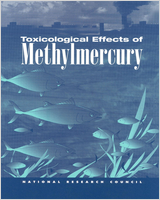NCBI Bookshelf. A service of the National Library of Medicine, National Institutes of Health.
Mercury is widespread in our environment. Methylmercury, one organic form of mercury, can accumulate up the aquatic food chain and lead to high concentrations in predatory fish. When consumed by humans, contaminated fish represent a public health risk.
Combustion processes, especially coal-fired power plants, are major sources of mercury contamination in the environment. The U.S. Environmental Protection Agency (EPA) is considering regulating mercury emissions from those plants.
Toxicological Effects of Methylmercury reviews the health effects of methylmercury and discusses the estimation of mercury exposure from measured biomarkers, how differences between individuals affect mercury toxicity, and appropriate statistical methods for analysis of the data and thoroughly compares the epidemiological studies available on methylmercury. Included are discussions of current mercury levels on public health and a delineation of the scientific aspects and policy decisions involved in the regulation of mercury.
This report is a valuable resource for individuals interested in the public health effects and regulation of mercury. The report also provides an excellent example of the implications of decisions in the risk assessment process for a larger audience.
Contents
- THE NATIONAL ACADEMIES
- COMMITTEE ON THE TOXICOLOGICAL EFFECTS OF METHYLMERCURY
- BOARD ON ENVIRONMENTAL STUDIES AND TOXICOLOGY
- COMMISSION ON LIFE SCIENCES
- OTHER REPORTS OF THE BOARD ON ENVIRONMENTAL STUDIES AND TOXICOLOGY
- PREFACE
- EXECUTIVE SUMMARY
- 1. INTRODUCTION
- 2. CHEMISTRY, EXPOSURE, TOXICOKINETICS, AND TOXICODYNAMICS
- 3. BIOLOGICAL VARIABILITY
- 4. DOSE ESTIMATION
- 5. HEALTH EFFECTS OF METHYLMERCURY
- 6. COMPARISON OF STUDIES FOR USE IN RISK ASSESSMENT
- ASSESSMENT OF PRENATAL Hg EXPOSURE: CORD BLOOD VERSUS MATERNAL HAIR AND TIMING OF EXPOSURE
- DIFFERENCES IN THE NEUROBEHAVIORAL END POINTS ASSESSED AND THE CHILDREN'S AGES AT ASSESSMENT
- STABLE VERSUS EPISODIC PATTERN OF EXPOSURE
- STUDY DIFFERENCES IN CONTROL FOR CONFOUNDERS
- POPULATION DIFFERENCES IN VULNERABILITY
- RANDOM VARIATION IN THE DETECTABILITY OF EFFECTS AT LOW EXPOSURES
- CONCLUSIONS
- RECOMMENDATIONS
- REFERENCES
- 7. DOSE-RESPONSE ASSESSMENT
- 8. RISK CHARACTERIZATION AND PUBLIC HEALTH IMPLICATIONS
- THE CURRENT EPA REFERENCE DOSE
- EVALUATING THE RfD–END POINTS OF MeHg TOXICITY
- SELECTION OF THE END POINT FOR THE RfD
- EXAMINATION OF THE CRITICAL STUDIES FOR THE RfD
- BMD CONSIDERATIONS: SELECTING A POINT OF DEPARTURE
- SELECTION OF THE CRITICAL STUDY AND POINT OF DEPARTURE FOR THE REVISED RfD
- SOURCES OF UNCERTAINTY: CONSIDERATION FOR UNCERTAINTY FACTORS
- IMPLICATIONS FOR PUBLIC HEALTH AND RISK MANAGEMENT
- COMMITTEE FINDINGS AND RECOMMENDATIONS
- REFERENCES
- APPENDIX TO CHAPTER 7
- GLOSSARY
This project was supported by Grant Agreement No. X 827238-01 between the National Academy of Sciences and the Environmental Protection Agency. Any opinions, findings, conclusions, or recommendations expressed in this publication are those of the author(s) and do not necessarily reflect the view of the organizations or agencies that provided support for this project.
NOTICE: The project that is the subject of this report was approved by the Governing Board of the National Research Council, whose members are drawn from the councils of the National Academy of Sciences, the National Academy of Engineering, and the Institute of Medicine. The members of the committee responsible for the report were chosen for their special competences and with regard for appropriate balance.
- NLM CatalogRelated NLM Catalog Entries
- Toxicological Effects of MethylmercuryToxicological Effects of Methylmercury
Your browsing activity is empty.
Activity recording is turned off.
See more...
